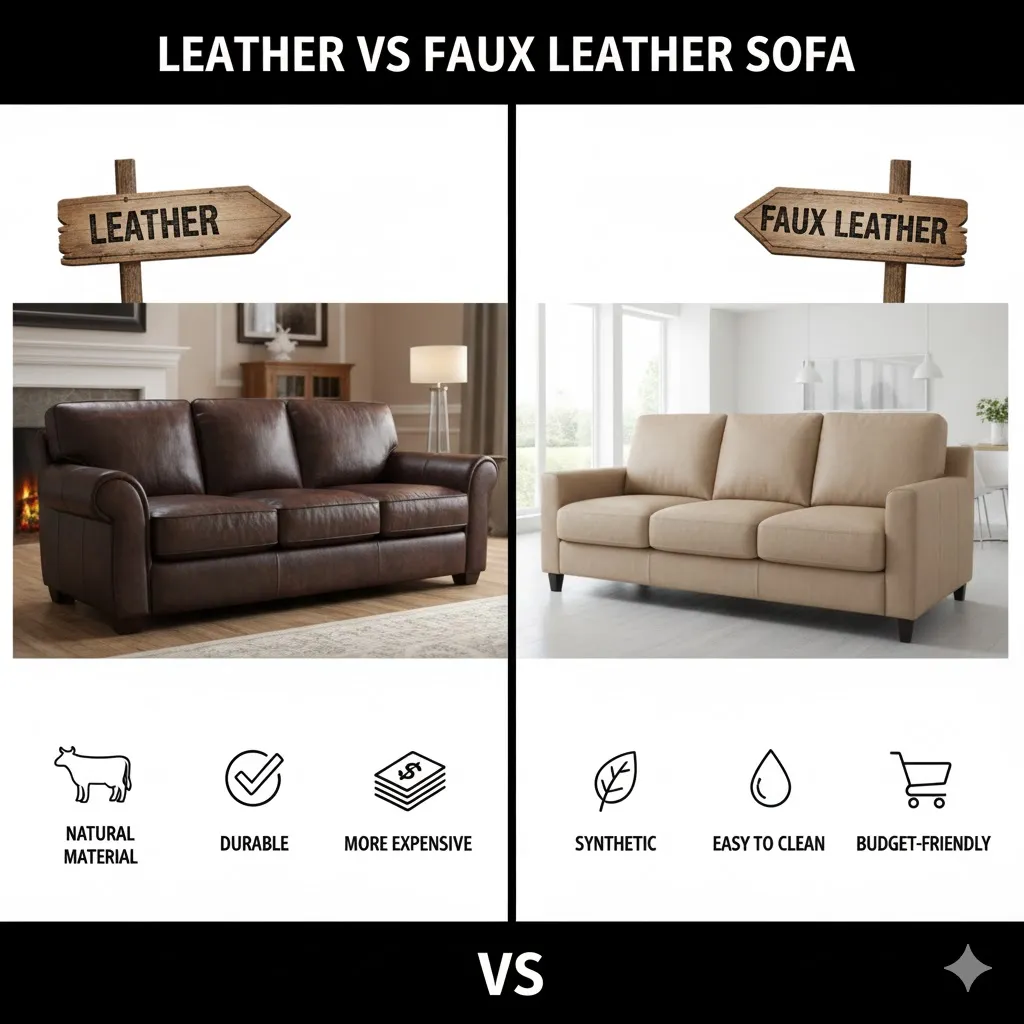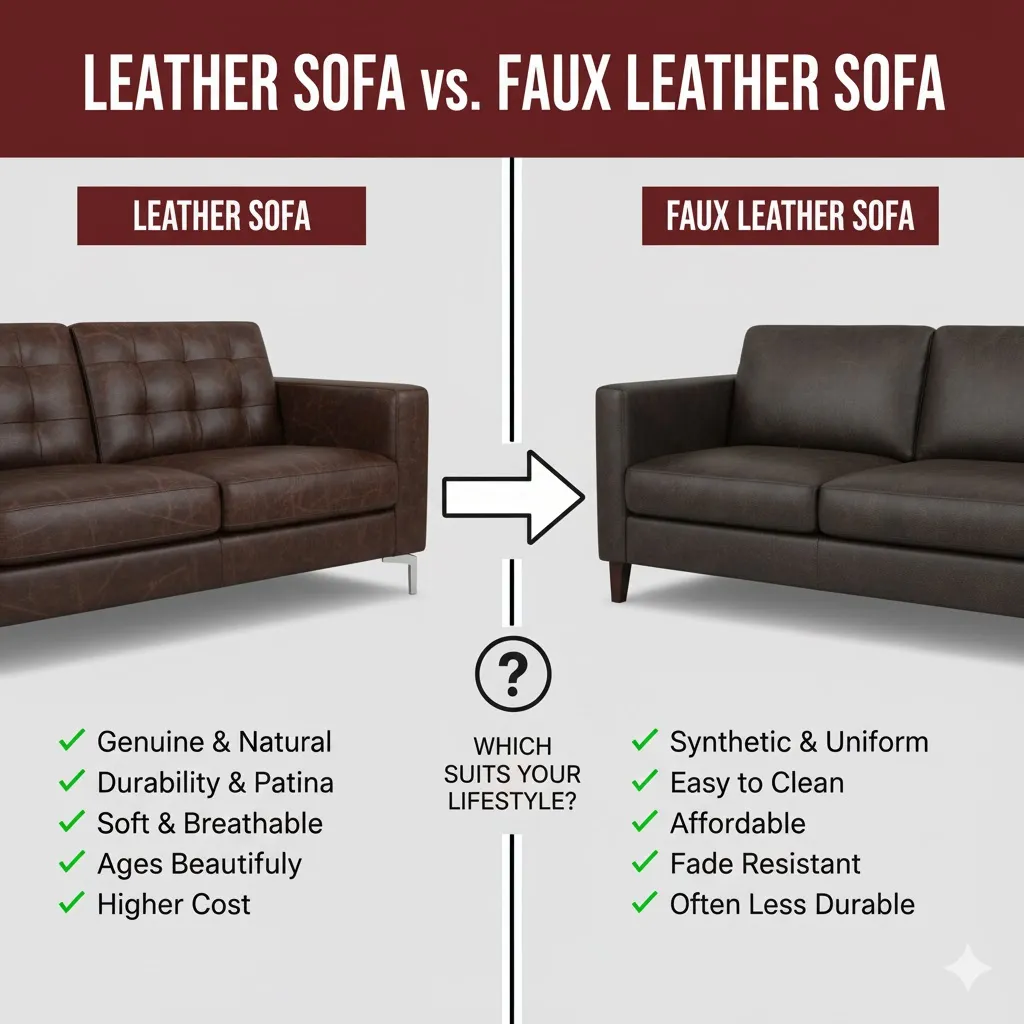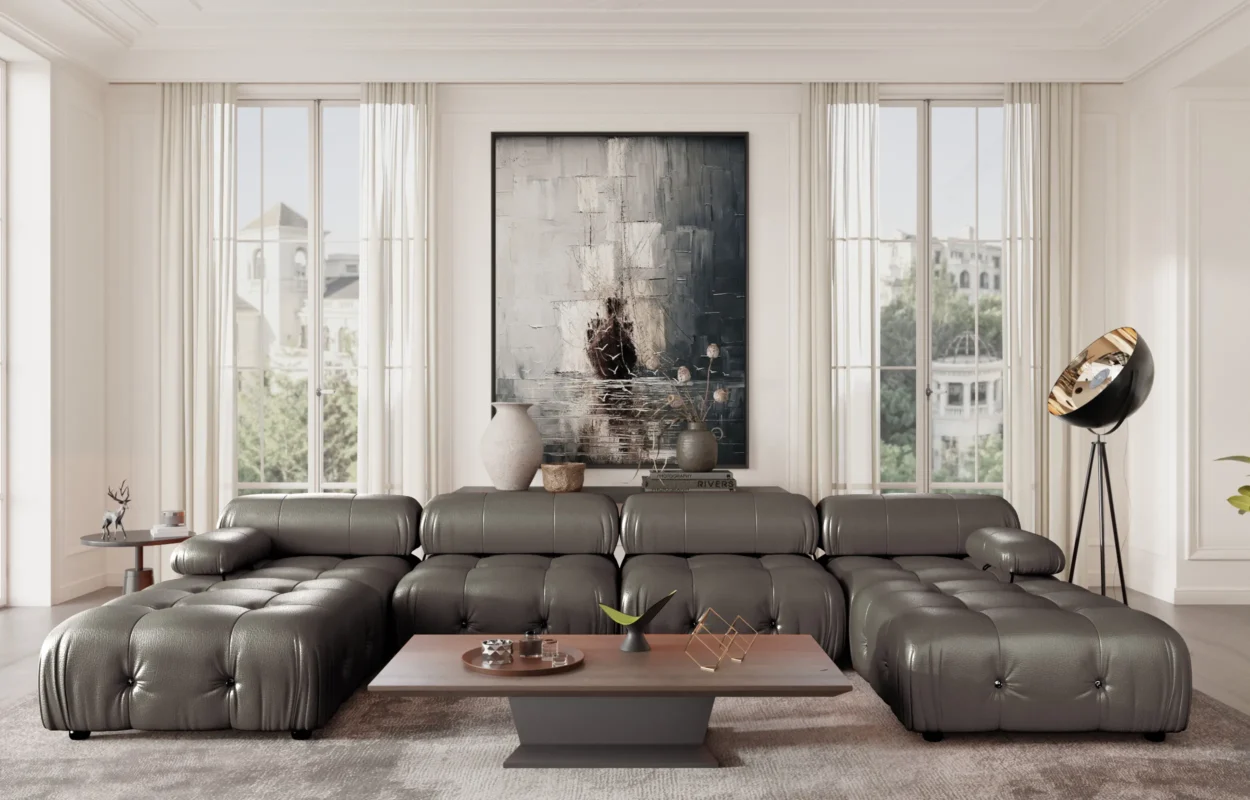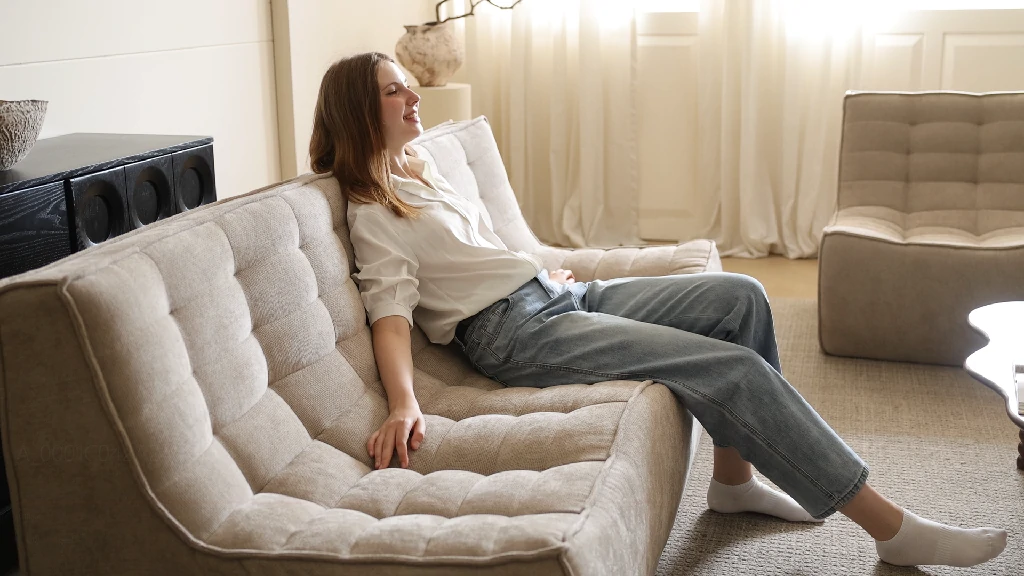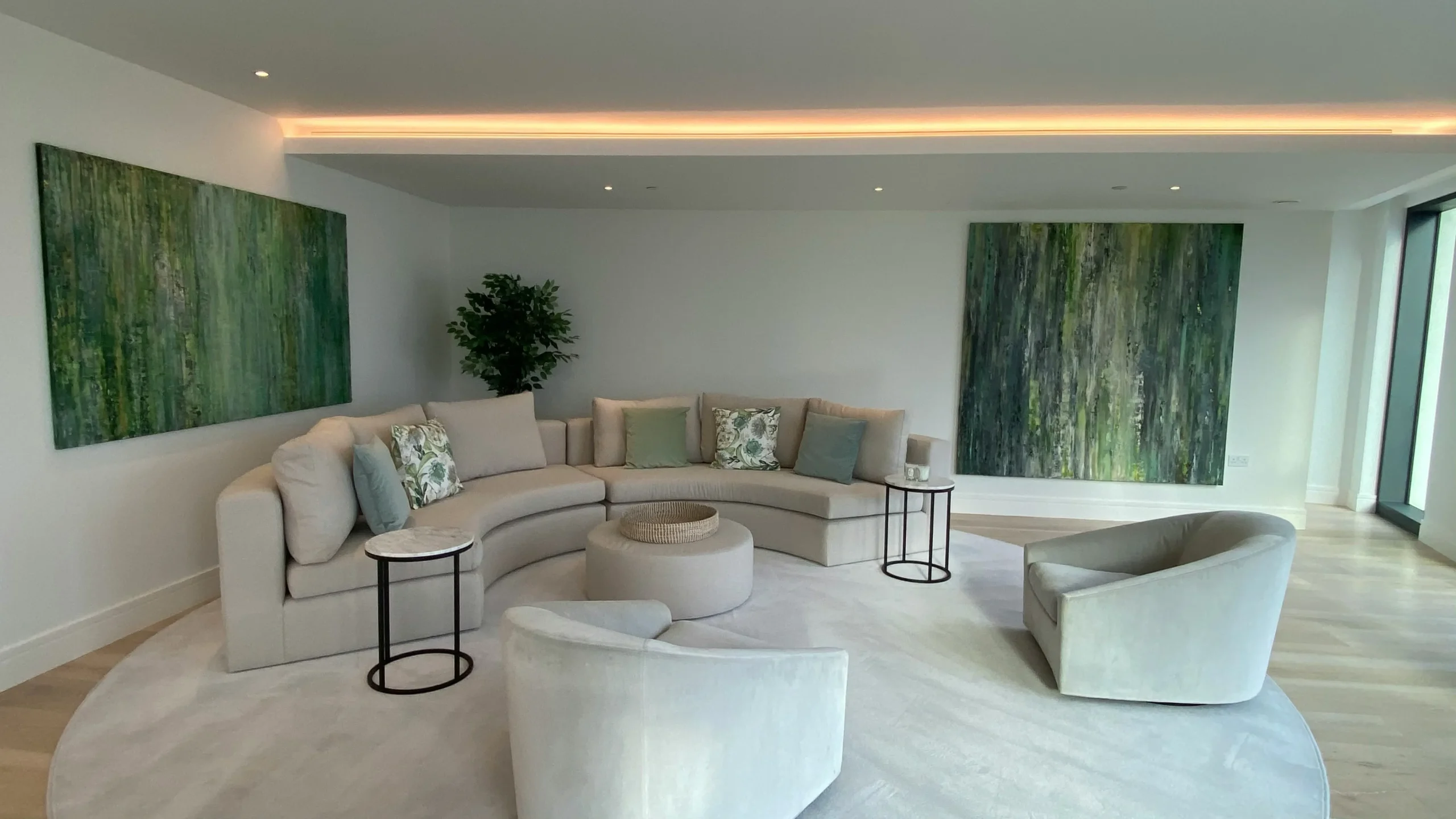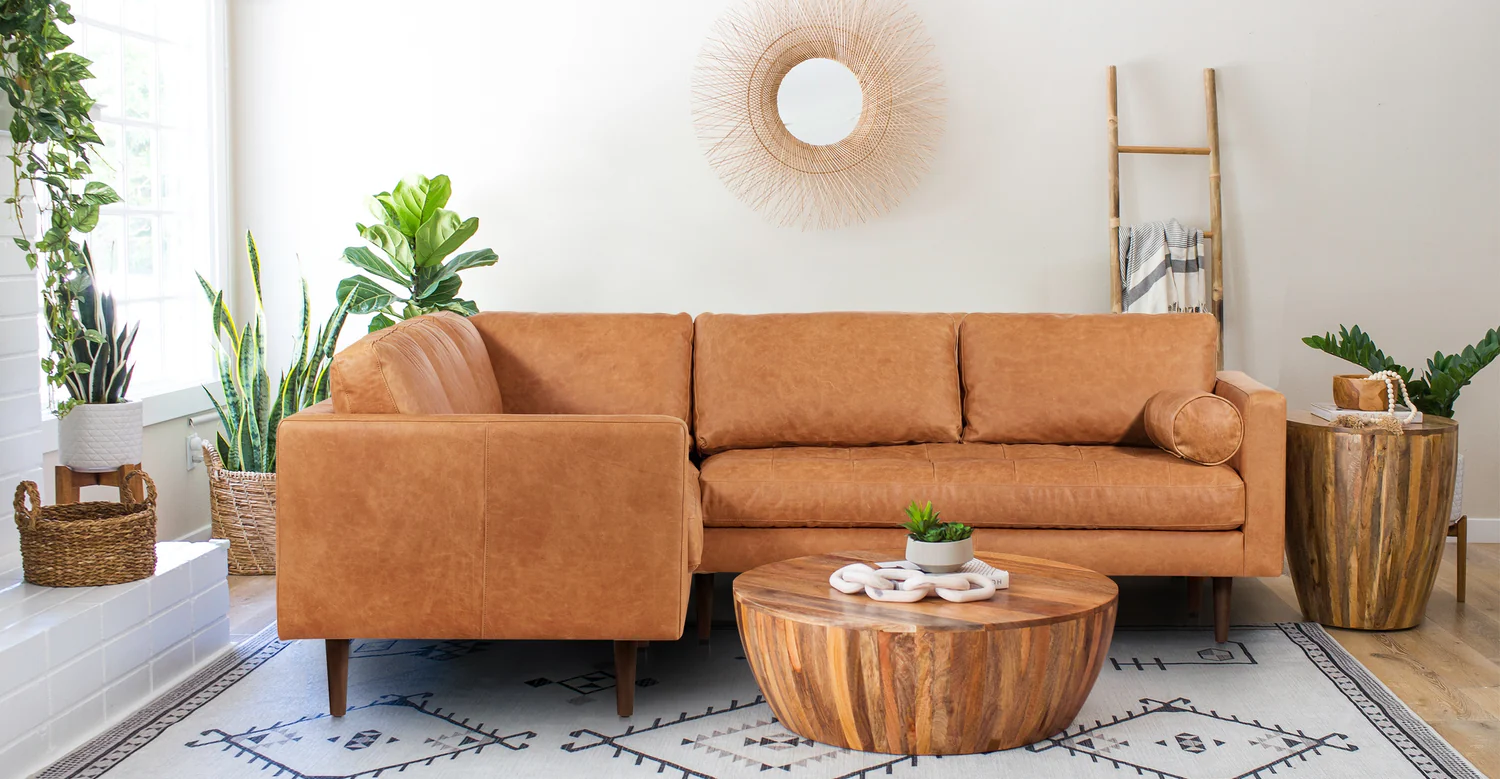The Leather vs Faux Leather Sofa debate is one many homeowners face when decorating their living rooms. Real leather brings that rich, timeless feel everyone loves. But faux leather offers a sleek look that’s easier on the wallet and simpler to maintain. Both have their perks — it just depends on what fits your lifestyle best. In this guide, we’ll walk you through the key differences in comfort, durability, care, and price to help you choose the sofa that feels just right for your home.
Leather vs Faux Leather Sofa: Which One Is Right for You?
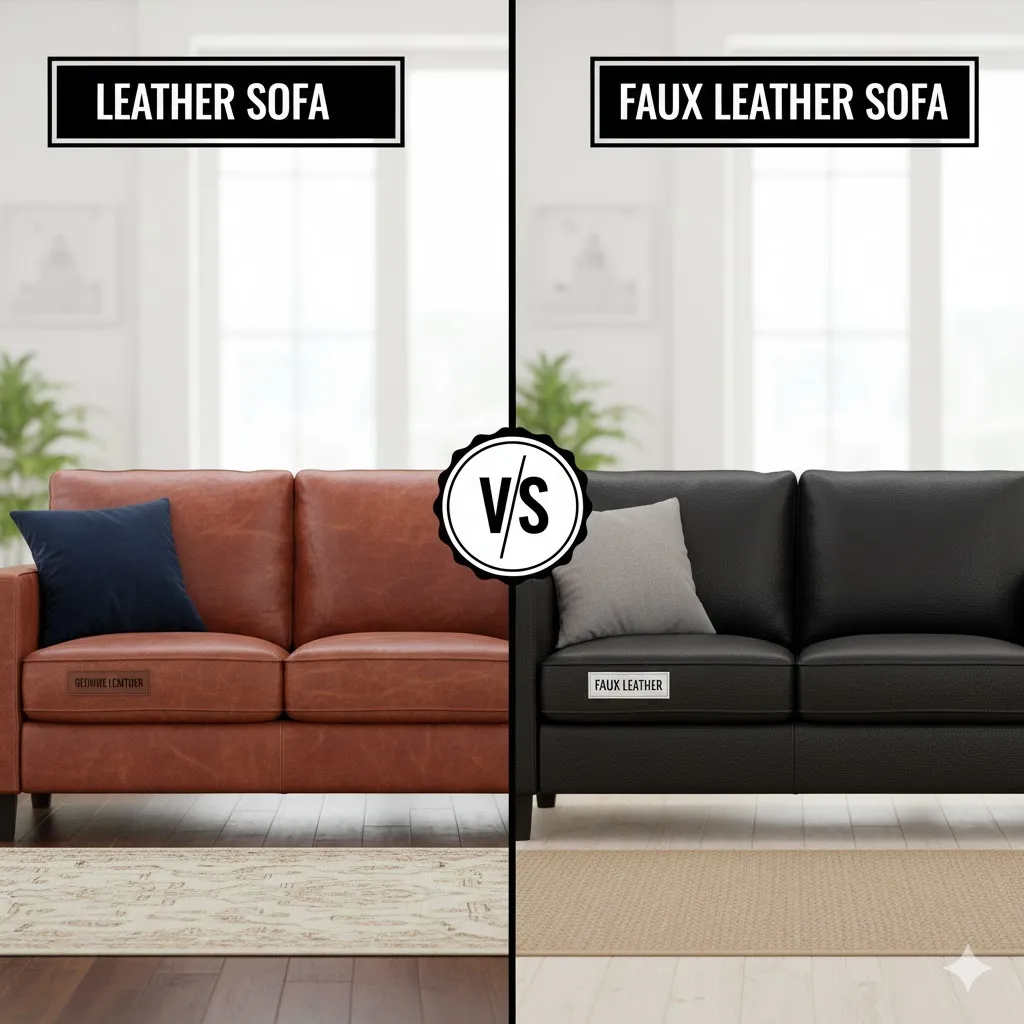
Understanding the Basics — Leather vs Faux Leather Sofa
What Is a Leather Sofa?
A leather sofa is made from genuine animal hide that’s carefully treated and dyed to enhance its durability and texture. It’s known for its natural grain, rich scent, and ability to develop a beautiful patina over time. Leather sofas often bring a sense of luxury and timeless style, making them a favorite for classic or upscale interiors.
What Is a Faux Leather Sofa?
A faux leather sofa is crafted from synthetic materials such as polyurethane (PU) or polyvinyl chloride (PVC), designed to mimic the look and feel of real leather. It offers a smooth, consistent texture and is completely animal-friendly. Faux leather sofas are popular in modern homes and apartments, especially for those who want a stylish, easy-care, and budget-conscious option.
Key Differences — Leather vs Faux Leather Sofa
Here’s a quick comparison to help you see the main differences between a Leather vs Faux Leather Sofa at a glance:
Category | Leather Sofa | Faux Leather Sofa |
Appearance and Texture | Natural grain, unique imperfections, and luxurious depth of color | Consistent finish, wide color options, easier to match décor |
Comfort and Feel | Softens over time and becomes more supple | Firmer texture, doesn’t breathe as well as real leather |
Durability and Longevity | Lasts 10–20 years with proper care; resistant to tearing | Lifespan of 5–10 years; can crack or peel with heavy use |
Maintenance and Cleaning | Needs occasional conditioning to prevent drying | Easy to wipe clean; low-maintenance for busy homes |
Cost Comparison | Typically ranges from $1,000–$4,000+ | More affordable at $400–$1,500 |
Sustainability and Ethics | Natural and biodegradable, but involves animal products | Cruelty-free, though less eco-friendly due to plastics |
When it comes to choosing between a Leather vs Faux Leather Sofa, it’s really about finding the right balance between look, feel, and lifestyle. Both materials have their own charm — one brings natural luxury, while the other offers convenience and affordability. Let’s explore the main differences in a simple, friendly way.
1. Appearance and Texture
Leather brings natural character and timeless beauty.
Every Leather vs Faux Leather Sofa comparison starts with appearance, and leather clearly stands out for its authenticity. Each leather sofa tells its own story, with unique grains, marks, and tones that make it one of a kind. Over time, real leather develops a rich patina that adds warmth and depth to your living space. It also reflects light beautifully, giving that elegant, high-end touch you just can’t fake.
Faux leather gives you consistency and color variety.
If you love a perfectly smooth, uniform surface, faux leather might be your pick. It’s available in a wide range of colors and finishes — from sleek matte to glossy modern styles — making it easy to match your décor. In the Leather vs Faux Leather Sofa debate, faux leather wins for flexibility and design variety, ideal for anyone who wants a clean, polished look without natural variations.
2. Comfort and Feel
Leather gets softer and cozier with time.
When comparing Leather vs Faux Leather Sofa comfort levels, real leather feels luxurious from day one and only gets better over time. It molds to your body, becoming more comfortable with every use. Leather breathes naturally, keeping you cool in summer and warm in winter — a feature that faux leather can’t quite match.
Faux leather feels firm and smooth, but less breathable.
Faux leather doesn’t have the same natural pores as genuine leather, so it can feel warmer in hot weather or cooler in winter. However, modern PU faux leather has improved greatly — it’s softer, more flexible, and far more comfortable than older versions. For many, this makes it a practical option in the Leather vs Faux Leather Sofa decision.
3. Durability and Longevity
Leather stands the test of time.
A key factor in the Leather vs Faux Leather Sofa choice is how long each material lasts. With proper care, a leather sofa can stay beautiful for 10 to 20 years or more. It’s strong against wear and tear, and small scratches often blend into the surface, adding to its charm. For long-term value, leather is hard to beat.
Faux leather is durable for everyday use, but not forever.
While faux leather holds up well for everyday living, it typically lasts 5 to 10 years before showing signs of wear. It’s more resistant to stains but can crack or peel with heavy use, especially in homes with pets or lots of sunlight. Still, when it comes to short-term affordability in the Leather vs Faux Leather Sofa comparison, faux leather is a smart choice.
4. Maintenance and Cleaning
Leather needs a little love and care.
Part of what defines the Leather vs Faux Leather Sofa difference is upkeep. Leather requires gentle cleaning and conditioning once or twice a year to stay soft and prevent drying. It’s not demanding, but it does appreciate some care — and in return, it rewards you with long-lasting beauty and comfort.
Faux leather is easygoing and simple to clean.
If you prefer a low-maintenance lifestyle, faux leather is the winner. Spills, dust, or pet hair? Just wipe it with a damp cloth and it’s good as new. No special products or conditioners are needed. This easy upkeep makes faux leather an appealing option for families in the Leather vs Faux Leather Sofa debate.
5. Cost Comparison
Leather is an investment in long-term quality.
When you’re weighing Leather vs Faux Leather Sofa prices, leather typically sits on the higher end — usually between $1,000 and $4,000+, depending on craftsmanship and design. Though the upfront cost is higher, its long life and timeless appearance make it a worthwhile investment for those who value quality.
Faux leather is stylish and budget-friendly.
Ranging from $400 to $1,500, faux leather sofas deliver the luxurious look of leather without stretching your budget. They’re a great option for renters, first homes, or anyone wanting that leather aesthetic without the big price tag. In the Leather vs Faux Leather Sofa comparison, faux leather clearly wins on affordability.
6. Sustainability and Ethics
Leather is natural but not cruelty-free.
From a sustainability perspective, the Leather vs Faux Leather Sofa choice isn’t black and white. Leather is natural and biodegradable but made from animal hide. Depending on how it’s processed, the tanning method can have environmental impacts, though some brands now use vegetable-based tanning for a greener alternative.
Faux leather is cruelty-free but made from synthetics.
Faux leather skips animal materials entirely, which appeals to vegan and eco-conscious shoppers. However, it’s made from plastics like PVC or PU, which aren’t as biodegradable. The good news is that more brands are introducing eco-friendly faux leather made from recycled or plant-based materials — a positive step toward sustainability in the Leather vs Faux Leather Sofa market.
Curious about leather sofa options? Explore our guide on Leather Sofa vs Fabric Sofa to see how materials, comfort, and style compare
When to Choose — Leather vs Faux Leather Sofa
1. When to Choose a Leather Sofa
A leather sofa is perfect if you want a luxurious, long-lasting centerpiece in your living room.
Choose leather if:
- You want a timeless, high-end look that adds elegance to your home.
- You need long-term durability — a sofa that can last 10–20 years with proper care.
- You prefer a material that softens and becomes more comfortable over time.
- You don’t mind occasional maintenance, like conditioning, to preserve its quality.
- You enjoy the natural feel, texture, and patina that develops with real leather.
Recommended options:
- Extrasoft Modular Sofa | Genuine Leather – Luxurious modular design for a cozy, elegant living space.
- LC2 Sofa | Black Goose Down Blend – Classic leather sofa combining comfort and sophistication.
2. When to Choose a Faux Leather Sofa
Faux leather is ideal if you want style and convenience without breaking the bank.
Choose faux leather if:
- You want a stylish, budget-friendly alternative that still looks like real leather.
- You prefer low-maintenance furniture that’s easy to clean.
- You have kids, pets, or high-traffic areas where spills and stains are common.
- You want more color and design options to match modern décor.
- You prefer a cruelty-free or vegan-friendly option for ethical reasons.
Recommended option:
- Sandra Sofa | Caramel Faux Leather – Elegant faux leather sofa combining comfort, style, and easy care.
Mistakes to Avoid — Leather vs Faux Leather Sofa
1. Overlooking Comfort and Usage Needs
Mistake: Choosing a sofa solely based on looks or price.
Tip: Think about who will use the sofa most and how often. A leather sofa may be perfect for daily lounging thanks to its softness over time, while faux leather works well for occasional use or homes with kids and pets. Balancing comfort with usage ensures your sofa remains enjoyable for years.
2. Not Considering Maintenance Requirements
Mistake: Underestimating cleaning and care needs.
Tip: Leather sofas need occasional conditioning to prevent drying or cracking, while faux leather is low-maintenance but can peel if not treated carefully. Understanding care requirements upfront helps avoid unpleasant surprises and keeps your sofa looking fresh.
3. Focusing Only on Price
Mistake: Buying the cheapest option without thinking about lifespan or quality.
Tip: Leather may have a higher upfront cost but can last 10–20 years, making it a long-term investment. Faux leather is budget-friendly and stylish but usually lasts 5–10 years. Balance cost with durability to get the best value for your home.
4. Ignoring Material Quality
Mistake: Not checking the grade of leather or type of faux leather.
Tip: Full-grain and top-grain leather are more durable and age beautifully, while PU faux leather is generally sturdier than PVC. Knowing the material quality helps you choose a sofa that will look great and perform well over time.
5. Skipping Warranty or Return Policies
Mistake: Assuming all sofas come with the same protection.
Tip: Always review manufacturer warranties and return policies before purchasing. This ensures you’re covered if the sofa has defects or doesn’t meet expectations, giving peace of mind for both leather and faux leather options.
Conclusion
Choosing between a leather vs faux leather sofa really comes down to balancing comfort, style, cost, and maintenance. Leather sofas offer timeless elegance, long-term durability, and a soft, natural feel that improves with age, while faux leather sofas provide a budget-friendly, low-maintenance option with versatile colors and modern designs.
Before making your decision, think about your lifestyle, how often the sofa will be used, and the long-term value you want from your investment. Whether you’re after luxury that lasts for decades or a stylish, easy-care sofa for a busy home, there’s a perfect option for you.
Ready to find your ideal sofa? Explore Atunus Home’s leather and faux leather sofa collections — stylish, comfortable, and designed to fit every budget and living space.
Frequently Asked Questions (FAQs) — Leather vs Faux Leather Sofa
1. Is faux leather durable enough for everyday use?
Yes, modern faux leather is durable for daily use. High-quality PU or bonded faux leather can handle regular sitting, minor spills, and light wear. However, it may start to show cracks or peeling after several years, especially in high-traffic homes or under direct sunlight. Choosing thicker, premium faux leather extends its lifespan and keeps it looking fresh longer.
2. Does real leather require special cleaning products?
Yes, leather benefits from occasional conditioning. While daily cleaning only requires a soft, damp cloth, periodic use of leather conditioners helps prevent dryness, cracking, and fading. Avoid harsh chemicals, which can damage the surface. With proper care, a leather sofa can remain supple and attractive for 10–20 years or more.
3. Which sofa is better for pets — leather or faux leather?
Faux leather is generally more pet-friendly. It’s easier to wipe clean and resists hair, dander, and minor scratches. Real leather is also durable but can show scratches from claws more easily. If you choose leather, selecting a thicker, top-grain variety helps minimize visible damage. Pet covers or throws are useful for either material.
4. Can faux leather look as good as real leather?
Yes, high-quality faux leather can mimic the appearance of real leather very closely. Modern PU and vegan leather options offer smooth, consistent textures, vibrant colors, and even embossed grain patterns. While it may lack the natural patina of real leather, it provides a sleek, polished look ideal for contemporary interiors.
5. Which option is more eco-friendly?
It depends on what you value. Real leather is biodegradable and long-lasting, which reduces replacements over time, but it comes from animal hide and may involve chemical tanning. Faux leather is cruelty-free, appealing to vegans, but is made from plastics like PU or PVC, which aren’t biodegradable. Some brands now offer recycled or plant-based faux leather, bridging sustainability and ethical concerns.

